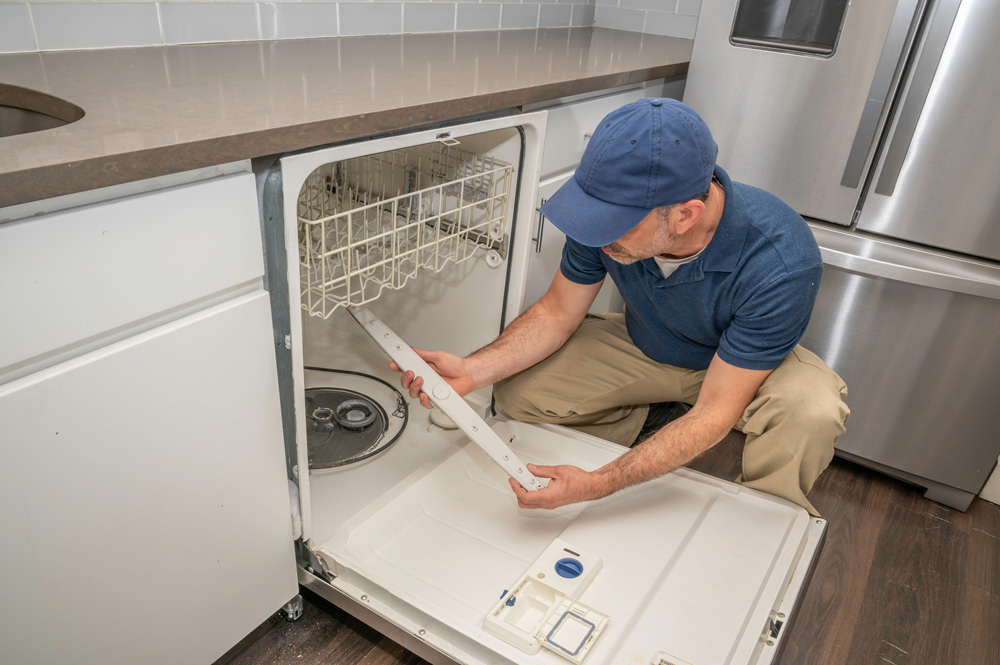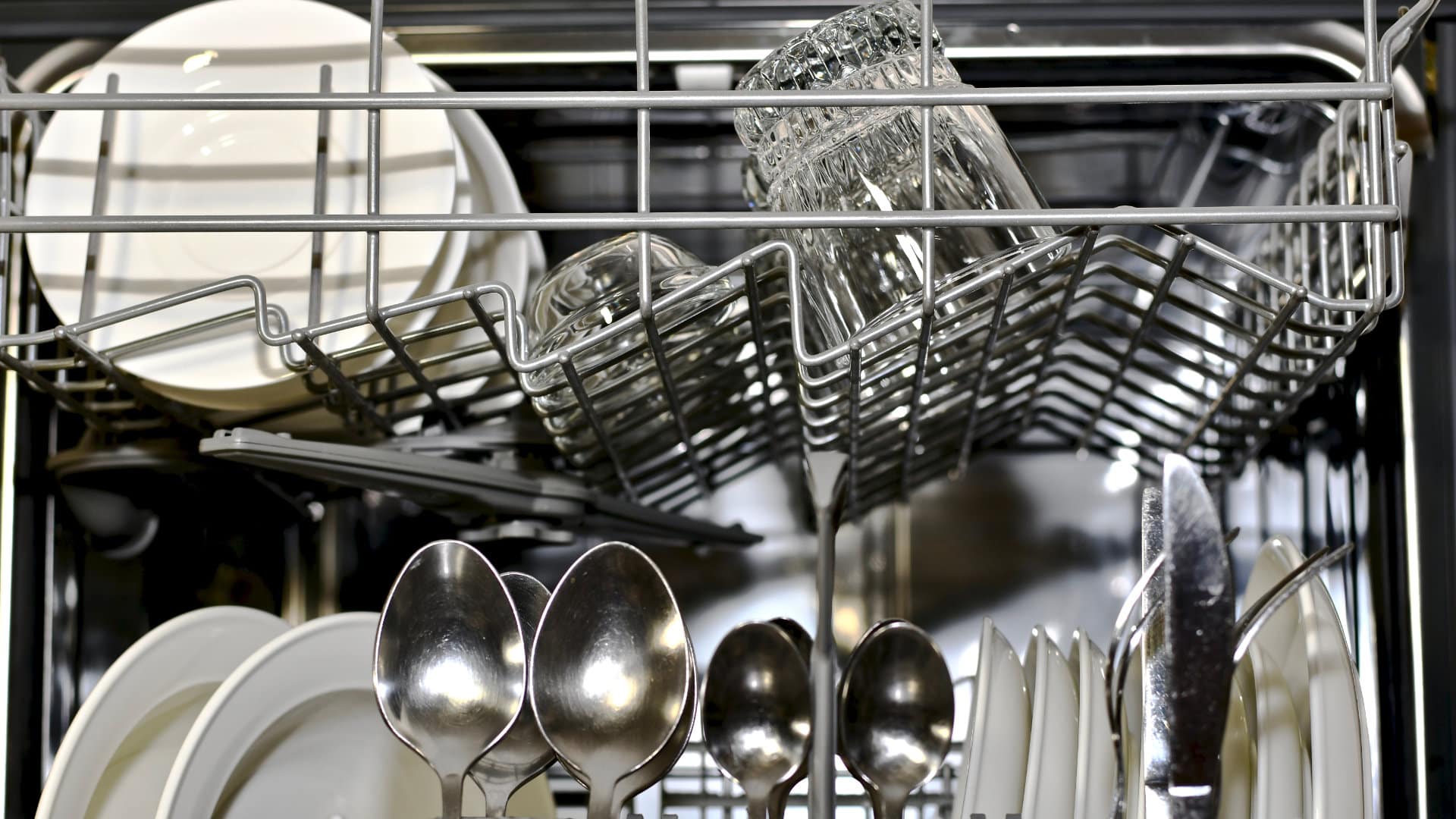Imagine this: You’ve just finished a delicious meal and loaded your trusty dishwasher with dishes from your family dinner. As you eagerly wait for the cycle to finish, you expect sparkling, clean dishes ready for the next culinary adventure.
But when you open the dishwasher door, your excitement turns to frustration. Those dishes on the top rack? Still dirty. You might find yourself wondering what went wrong. You’re not alone. Many people face this common issue, and it’s not just about a minor inconvenience.
Your dishwasher’s performance can impact your daily routine and peace of mind. If your top rack dishes aren’t coming out clean, it could be a sign of underlying problems that need your attention. We will uncover the possible reasons behind this dilemma and provide practical solutions to ensure your dishwasher works like a charm. Get ready to say goodbye to those stubborn stains and hello to perfectly clean dishes every time!

Credit: fixappliances.ca
Common Causes
A dishwasher that doesn’t clean the top rack can frustrate anyone. Understanding the common causes helps address the problem effectively. Often, simple fixes can restore its optimal performance. Let’s explore some frequent culprits behind this issue.
Clogged Spray Arms
Clogged spray arms often lead to poor cleaning results. Over time, food particles and debris can block the tiny holes. This blockage prevents water from reaching the top rack effectively. Regularly check and clean these spray arms to ensure they function correctly.
Improper Loading
Improper loading can hinder water flow, impacting cleaning results. Placing large items or stacking dishes too tightly can block water. Ensure dishes are not touching and leave space for water circulation. This simple step can significantly improve cleaning performance.
Low Water Pressure
Low water pressure can also affect the dishwasher’s cleaning ability. Insufficient pressure means water cannot reach the top rack properly. Check your home’s water pressure if dishes aren’t getting clean. Sometimes, a plumbing issue might need addressing to fix this problem.

Credit: viaappliance.com
Inspecting Spray Arms
Your dishwasher should clean dishes effortlessly. But sometimes, the top rack gets neglected. This issue often lies in the spray arms. They play a crucial role in distributing water. Ensuring their proper function is key to clean dishes.
Removing Blockages
Spray arms can get blocked easily. Food particles or mineral deposits can clog them. This disrupts water flow to the top rack. To fix this, remove the spray arms carefully. Check each opening for debris. Use a toothpick or soft brush to clear blockages. This simple step can restore proper cleaning.
Checking For Damage
Damage to spray arms can hinder their function. Cracks or bends affect water distribution. Inspect each arm closely for visible damage. Replace any damaged arm immediately. This ensures consistent water pressure and coverage. A minor repair can make a big difference.
Optimizing Loading Techniques
Are you frustrated with your dishwasher leaving dishes on the top rack dirty? You’re not alone. Many people find their top rack dishes aren’t getting the clean they expect. The problem might not be your dishwasher—it could be how you load it. Optimizing loading techniques can make all the difference. Let’s dive into some practical tips to help your dishwasher do its best work.
Spacing Dishes Properly
Proper spacing is key to ensuring each dish gets cleaned. Think about it: if dishes are too close, water and detergent can’t reach all surfaces. Leave space between each plate, cup, and utensil. Try staggering items rather than lining them up in a neat row. This approach helps water flow freely, reaching every nook and cranny.
Consider how you place bowls and cups. Tilt them slightly instead of placing them flat. This allows water to drain effectively, preventing residue build-up. How did you arrange your dishes last time? Could a slight adjustment change the outcome?
Avoiding Overloading
Overloading your dishwasher is like cramming too many clothes into a washing machine. It might seem efficient, but it impacts performance. Overloading prevents proper water circulation. Each dish needs enough room for water to reach it effectively.
Think about your last load. Did you squeeze in an extra plate or two? A lighter load often results in cleaner dishes. Is it time to reconsider how many items you’re trying to fit in? Less is often more when it comes to dishwashing.
If you’ve been struggling with not-so-clean dishes, these simple adjustments might be the solution. How will you change your loading habits to achieve the sparkling results you want?
Adjusting Water Pressure
Low water pressure can cause dishes on the top rack to remain dirty. Check your dishwasher’s water pressure settings. Ensure it’s adequate for effective cleaning.
A dishwasher that leaves dishes on the top rack dirty can be frustrating. One key factor in ensuring your dishwasher works effectively is adjusting the water pressure. If the water isn’t reaching the top rack, your dishes may not get the thorough cleaning they need. Understanding how to manage your dishwasher’s water pressure can make a big difference. But how do you go about this? Let’s dive into some practical solutions.Cleaning The Filter
Start by examining the dishwasher’s filter. A clogged filter can reduce water pressure, affecting cleaning performance. To clean it, remove the filter and rinse it under warm water. Use a soft brush to scrub away any stubborn debris. Regularly cleaning the filter can enhance water flow and improve the dishwasher’s efficiency.Ensuring Proper Connections
Check the water supply line and connections. A kinked or improperly connected line can restrict water flow, leading to low pressure. Make sure the hose is straight and securely attached. If you notice any damage, it might be time to replace the hose. Ensuring everything is properly connected can restore adequate water pressure, allowing your dishwasher to clean effectively. Adjusting your dishwasher’s water pressure can often solve the issue of dirty dishes on the top rack. What adjustments have you tried, and how did they work out for you?Ensuring Effective Detergent Use
A dishwasher not cleaning dishes on the top rack can be frustrating. Often, the issue might stem from detergent use. Using detergent effectively is key to cleaner dishes. Understanding how to choose, measure, and dispense detergent can make a big difference.
Choosing The Right Detergent
Dishwasher detergents come in powders, gels, and pods. Each type has unique benefits. Powders offer flexibility in use. Gels dissolve easily, reaching dishes faster. Pods provide pre-measured convenience. Consider water hardness and dishwasher model when selecting. Some detergents work better with specific dishwasher types. Read labels and user manuals for guidance.
Proper Measuring And Dispensing
Using too much detergent can cause residue. Too little may leave dishes dirty. Follow the instructions on the detergent package. Measure detergent according to load size and soil level. Use the dispenser designed for your dishwasher model. Ensure the dispenser is clean and not clogged. A clean dispenser ensures detergent releases properly. This helps achieve optimal cleaning results.
Regular Maintenance Tips
Troubleshooting a dishwasher that doesn’t clean the top rack can be simple. Check for clogged spray arms and ensure they spin freely. Regularly clean the filter and inspect water lines for blockages to maintain optimal performance.
Having a dishwasher not cleaning dishes on the top rack can be frustrating, especially when you expect spotless results every time. Regular maintenance can often solve these issues and keep your dishwasher running efficiently. These simple yet effective tips can help you ensure that your dishwasher remains in top condition.Routine Cleaning Tasks
You might be surprised how much of a difference routine cleaning can make. Start by checking the spray arms. Food particles can clog the holes, affecting water flow. Remove the spray arms and rinse them under warm water. Use a toothpick to gently clear any blockages. Don’t forget to clean the filter regularly. A clogged filter can impede water drainage, leading to poor cleaning performance. Run a cycle with a dishwasher cleaner once a month. This helps remove any build-up of limescale and grease. Have you ever thought about the interior door edges? These can harbor grime over time. Wipe them down with a damp cloth to keep them clean.Checking For Wear And Tear
Regularly inspect your dishwasher for signs of wear and tear. Check the door seals for any cracks or damage. A faulty seal can lead to water leakage and reduced cleaning efficiency. Look at the condition of the racks. If the coating is worn away, rust can form, which might transfer to your dishes. Consider replacing damaged racks. Inspect the spray arms for any signs of wear. Wobbly or damaged arms might not distribute water evenly. Tighten any loose parts or replace damaged spray arms to ensure optimal performance. Have you ever noticed strange noises during a wash cycle? This could indicate an issue with the motor or pump. Listen carefully and address unusual sounds quickly to avoid larger problems. Regular maintenance is key to keeping your dishwasher performing well. By incorporating these tasks into your routine, you can extend the life of your appliance and ensure it cleans effectively. What maintenance habit will you start today?When To Call A Professional
Dishes on the top rack not getting clean? It might be time to call a professional. Persistent problems could mean deeper issues needing expert help.
Is your dishwasher not cleaning dishes on the top rack? At times, simple troubleshooting can solve the problem. But persistent issues might need expert help. Knowing when to call a professional can save you time. It also ensures your appliance functions properly.Identifying Persistent Issues
Persistent issues suggest deeper problems. If the dishwasher repeatedly fails to clean the top rack, it’s a sign. Water flow may be restricted. Or, the spray arm might be clogged. Regular maintenance checks should fix minor issues. But if they persist, it’s best to seek expert advice.Recognizing Mechanical Failures
Mechanical failures often require professional intervention. If the spray arm doesn’t spin, it might be broken. The pump or motor could also malfunction. Unusual noises often indicate mechanical problems. Such issues are complex and need specialized tools. Calling a professional ensures accurate diagnosis and repair. `
Credit: www.domex-uk.co.uk
Frequently Asked Questions
Why Is My Dishwasher Not Cleaning The Top Rack?
Blocked spray arms can cause poor cleaning. Check for debris or food particles obstructing water flow.
How Do I Fix A Dishwasher’s Top Rack Cleaning Issue?
Clean the spray arms and unclog any blocked holes. Ensure the top rack is not overloaded.
Could Water Pressure Affect Top Rack Cleaning?
Yes, low water pressure reduces cleaning efficiency. Ensure your dishwasher has adequate water supply.
Should I Pre-rinse Dishes Before Using The Dishwasher?
Not necessary, but scraping off large food particles helps. It prevents clogs and improves cleaning.
Can Detergent Choice Impact Top Rack Cleaning?
Yes, some detergents work better. Use quality dishwasher detergent for optimal results.
Conclusion
Fixing a dishwasher can be simple. Start by checking the spray arms. Ensure they rotate freely. Clean any clogs you find. Inspect the filter. A blocked filter can cause issues. Check water temperature, too. It should be hot enough. Examine the detergent type and quantity.
Use the right amount. Make sure dishes are loaded correctly. Overloading can block water flow. Regular maintenance helps keep your dishwasher efficient. If problems persist, consider professional help. It might be necessary for complex issues. Keeping these tips in mind ensures cleaner dishes every time.
Enjoy hassle-free dishwashing!
